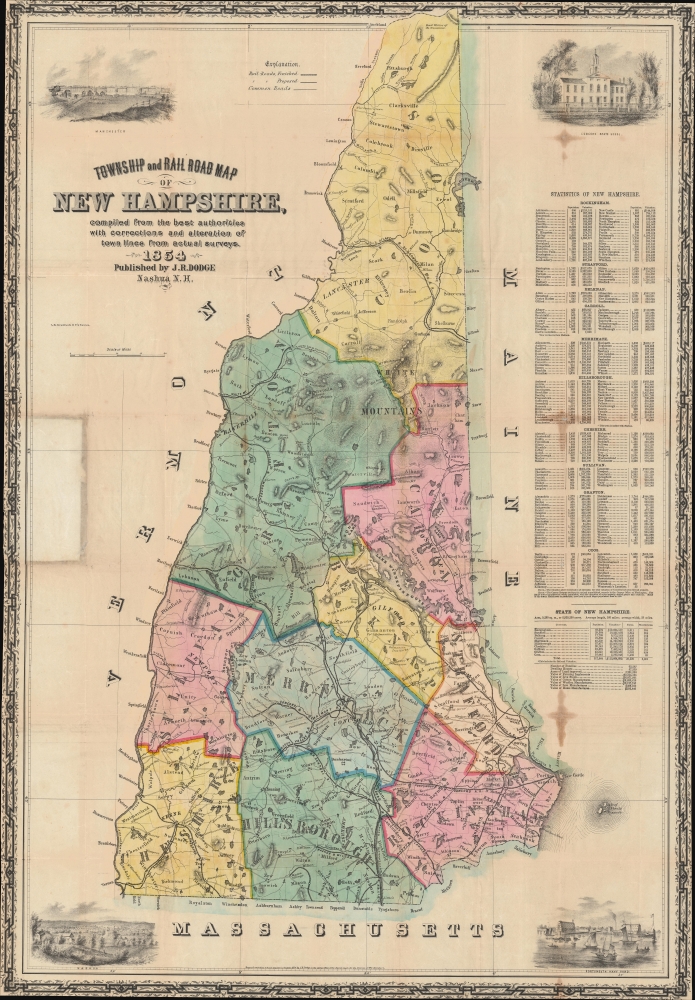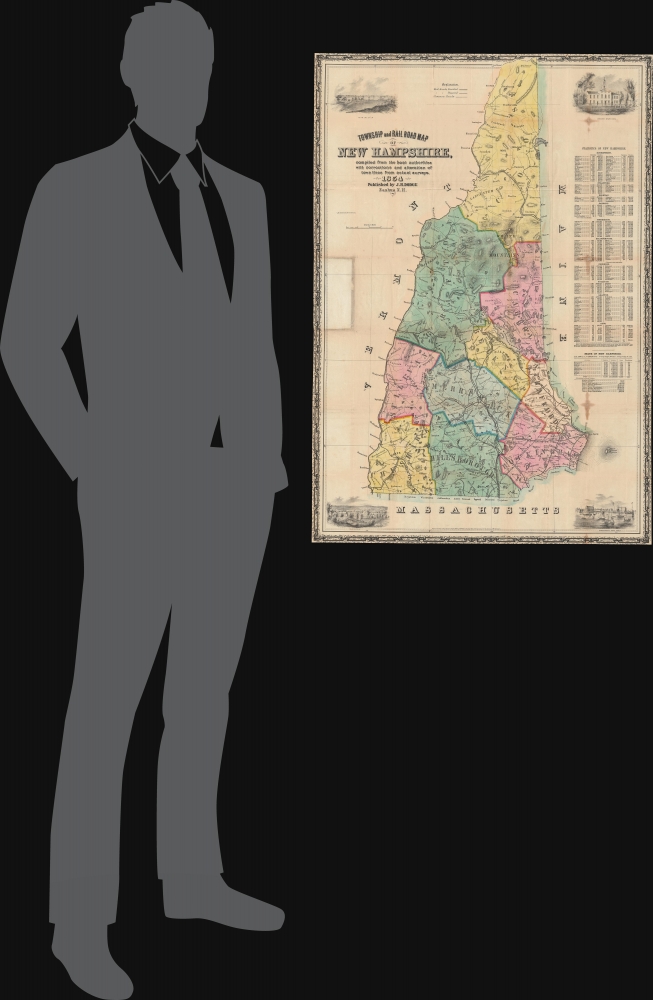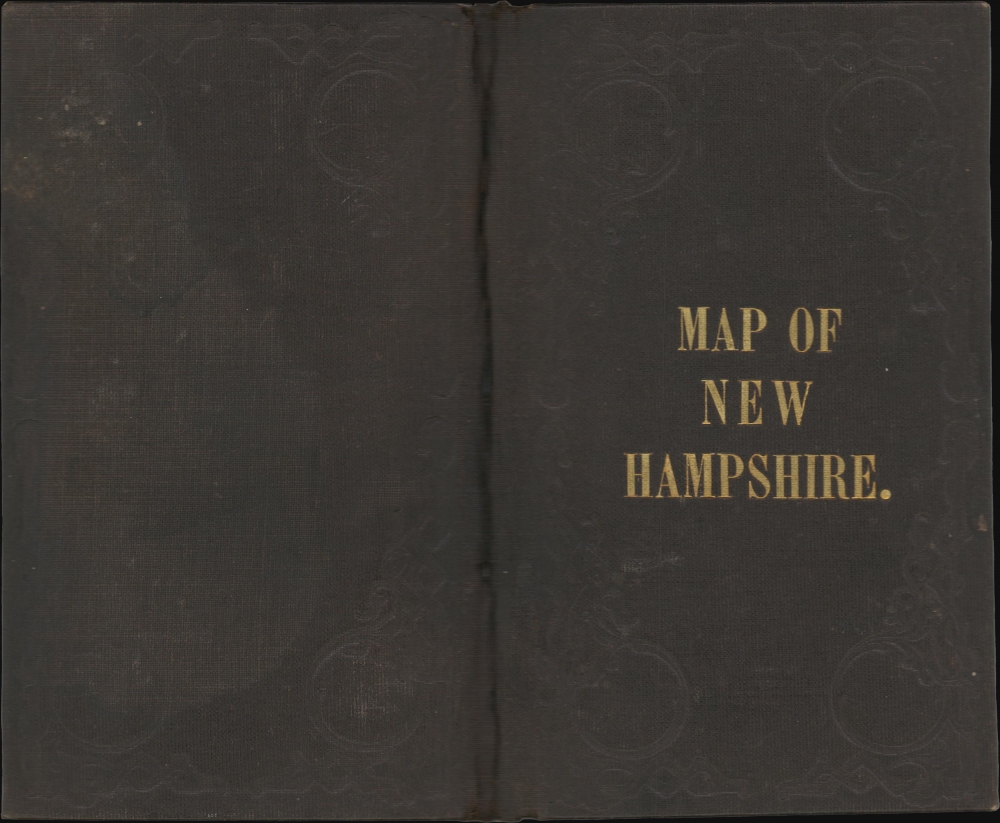1854 Dodge Map of New Hampshire (First Edition)
NewHampshire-dodge-1854-2
Title
1854 (dated) 34.75 x 24.25 in (88.265 x 61.595 cm) 1 : 506880
Description
Town Views
Views of the state house in Concord and the harbor town of Portsmouth occupy the corners on the right. Together these two cities represent the pre-industrial centers of New Hampshire's government and economy. As if in contrast to the old guard, the left hand views illustrate the booming industrial centers of Manchester and Nashua, both of which benefited from the rise of railroads and refocus the economy along the Merrimack corridor.Publication History and Census
This map was engraved by L. H. Bradford of Boston and published by Dodge in Nashua in 1854. Dodge published at least four editions of the present map. The first edition, present example, was published in 1854. A second edition was also published in 1855, with numerous updates. A third edition appeared in 1856, and a fourth in 1860. We note three examples of the 1854 edition cataloged in OCLC: Phillips Exeter Academy, Yale University, and Dartmouth College. Rare to the market.CartographerS
Jacob Richard Dodge (September 28, 1923 - c. 1890) was an American publisher, poet, and journalist. Born in New Boston, New Hampshire, Dodge learned the art of printing in the offices of the Amherst Cabinet, a local newspaper. After graduating from school he accepted a post as a schoolmaster in Mississippi, where he remained for five years, before returning to Nashua, New Hampshire. During this period in Nashua he published his only map, a railroad guide and wall map of New Hampshire. In 1855 he moved to Ohio, where he published the American Ruralist, a regional agricultural newspaper. In 1861 Dodge again relocated, this time to Washington D. C. There he took a position as Senate Reporter for the National Intelligencer. From 1866 to 1878 he worked as Statistician for the Department of Agriculture. In this role he was sent to Europe to represent United States agriculture at the 1873 Vienna Exhibition. Dodge continued to work in statistics with the U.S. Government until the 1880s. It is unclear when Dodge died.3 More by this mapmaker...
Lodowick Harrington Bradford (November 10, 1820 - December 13, 1885) was a Boston based engraver lithographer active in the second half of the 19th century. Bradford was born in Boston, Massachusetts. He studied as a line engraver before transitioning to the then new art of lithography. He even invented his own photolithographic ambrotype process that created a durable photographic picture on lithographic stone. In 1849 he partnered with Ebenezer Tappen (1815 - 1854) to form the Boston firm of Tappan and Bradford. The partnership remained active until Tappan's untimely death in January, 1854. From 1854 to 1859 Bradford continued to operate the firm, but the imprint changed to 'L. H. Bradford and Company.' It is not clear who the 'and Company' was, possibly Tappan's heirs? From late 1859 until his 1870, he printed under 'L. H. Bradford.' His last known lithographs appeared in 1860, but he did continue copper and steel engraving until his death. Bradford was married to Martha Brown, from an old Gloucester Family. After his wedding in 1849, he divided his time between Gloucester and Boston. In Gloucester he made the acquaintance of the local painter Fitz Henry Lane (1804 - 1865) and worked with him to produce several views in the 1850s. He died on the road between Boston and Gloucester in 1885. Learn More...






